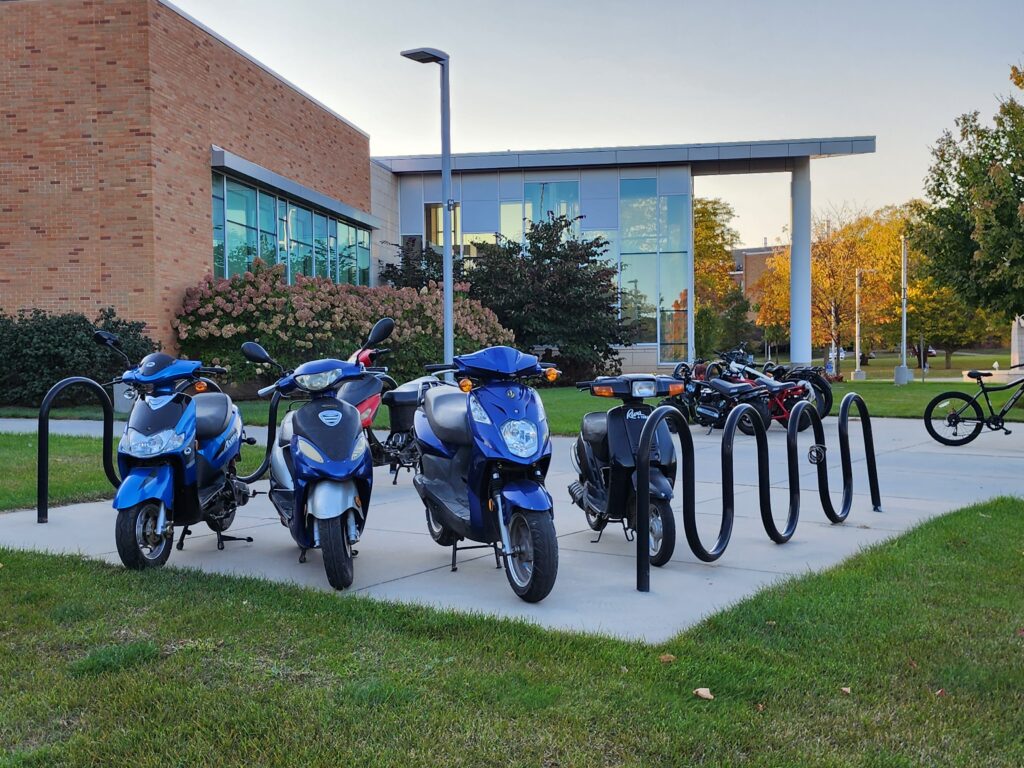Electric scooters, bikes, skateboards and mopeds are quickly becoming a common sight on college campuses across the country, particularly in Big Rapids.
As universities expand and students face increasingly demanding schedules, these new forms of transportation have emerged as a solution to the challenge of getting from class to class efficiently. As a faster, eco-friendly alternative to walking, e-mobility promises to revolutionize campus commutes.

While these innovations help students save time and improve their daily routines, they also come with social and cultural consequences that some students are beginning to notice. E-mobility is transforming student life by balancing the benefits of efficiency with the potential downsides of reduced social interaction.
Business administration junior Morgan Sanocki is one of many students who has found e-transportation to be a game-changer.
“These new forms of transportation can create better time management principles for students,” Sanocki said.
Indeed, as campus schedules become increasingly demanding, many students see e-bikes and scooters as a solution to the ever-present problem of rushing between buildings without the stress of being late. Efficiency seems to be a major selling point.
Finance sophomore Kaden Karroma echoed this sentiment, praising the convenience these modes of transport provide.
“It allows for a good efficiency of students,” Karroma said. “When walking, it takes almost thirty minutes to get from one end of campus to the other, but these allow people to get from one end to another in five to 10 minutes.”
For busy students juggling classes, part-time jobs and extracurriculars, this added efficiency has become essential. Not all students are fully on board with the trend, however. While these sleek new machines may make life easier, they come at a social cost.
Mechanical engineering technology freshman Cameron Handwerker expressed concerns about how these electric options might impact the traditional social dynamic on campus.
“These new forms of transportation seclude people from conversating while walking,” Handwerker said.
As someone who initially embraced the electric longboard trend, Handwerker quickly realized its unintended consequence.
“I only used it for a short while before realizing this effect on social impacts,” Handwerker said.
Walking to class, once a time for casual conversations and spontaneous meetups, is gradually being replaced by quick, isolated rides across campus. The stroll between buildings, which often allowed students to bump into friends, chat about their day or even make new connections, is becoming less common as e-scooters, bikes and skateboards zip past.
These brief interactions, though small, have traditionally contributed to the sense of community on campus, offering opportunities to catch up, discuss class material or even make impromptu study plans. Without them, the campus environment can feel more fragmented, as students now travel in their bubbles, earbuds in, focused on getting to their destination as quickly as possible.
While the efficiency of e-transportation is undeniable, it’s the spontaneous social moments may slip away in the process. These small pockets of time used to be crucial for creating a vibrant campus atmosphere where students felt connected. The quick transitions between locations mean fewer chances to have those organic conversations, which can lead to a growing sense of isolation.
Some students have expressed concern that this shift, while beneficial for managing time, may come at the expense of the social fabric that has long been a hallmark of college life. In the long run, the speed and convenience of e-mobility could reshape the dynamics of how students engage with each other on campus, leading to a quieter, more individualistic experience.
In response to these growing trends, universities are beginning to evaluate the broader impact of e-mobility on campus culture. Some are considering designated e-transportation lanes, while others are launching initiatives to maintain pedestrian zones that encourage walking and conversation. As campuses become more connected through technology, students and faculty are grappling with the balance between efficiency and social interaction.
The rise of e-transportation on campus reflects the dual nature of technological advancement: for every leap forward in convenience, there is often a cost to the more intangible elements of daily life. While these sleek, battery-powered vehicles are helping students like Sanocki and Karroma navigate their busy schedules more effectively, the question remains: at what social cost?
As the popularity of e-mobility continues to grow, it seems students will have to decide whether the trade-off is worth it or if there is a way to merge the best of both worlds—faster commutes and those all-important social connections.
